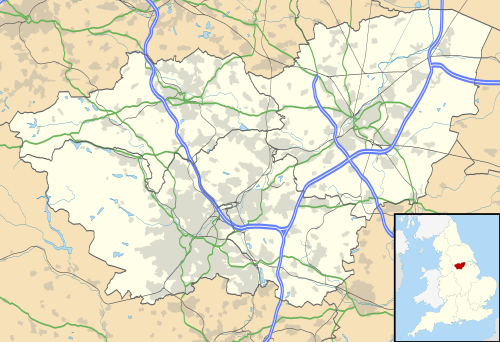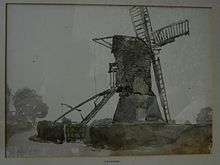Thorne, South Yorkshire
| Thorne | |
 St Nicholas's Church, Thorne |
|
 Thorne |
|
| Population | 17,295 (2011) |
|---|---|
| OS grid reference | SE687132 |
| Civil parish | Thorne |
| Metropolitan borough | Doncaster |
| Metropolitan county | South Yorkshire |
| Region | Yorkshire and the Humber |
| Country | England |
| Sovereign state | United Kingdom |
| Post town | Doncaster |
| Postcode district | DN8 |
| Dialling code | 01405 |
| Police | South Yorkshire |
| Fire | South Yorkshire |
| Ambulance | Yorkshire |
| EU Parliament | Yorkshire and the Humber |
| UK Parliament | Don Valley |
Coordinates: 53°36′30″N 0°57′30″W / 53.6083°N 0.9583°W
Thorne is a market town and civil parish in the Metropolitan Borough of Doncaster in South Yorkshire, England. It has a population of 16,592,[1] increasing to 17,295 at the 2011 Census.[2]
History
The land which is now Thorne was once inhabited by Neolithic, Bronze Age and Iron Age people. It became a permanent settlement around AD700, and is mentioned in the Domesday Book. The main industries in the town have traditionally been coal mining and farming.
Geography
Thorne lies east of the River Don, on the Stainforth and Keadby Canal, and is located at approximately 53°36′30″N 0°57′30″W / 53.60833°N 0.95833°W, at an elevation of around 16 feet (5 metres) above sea level, on the Yorkshire side of the border with Lincolnshire. The civil parish of Thorne includes the village of Moorends to the north.
Culture and community
Thorne Memorial Park is the location for the Thorne Memorial Park Miniature Railway and the annual Thorne Festival. During the summer months, free brass band concerts are held at the park's bandstand.
Thorne Community Wood is a community woodland created from agricultural land by Thorne-Moorends Town Council, and The Peatlands Way, a circuitous walk around the wildlife areas of Thorne and Hatfield Moors, passes to the north of the town.[3]
Thorne's Farmers' Market is a monthly event. The area now has its own Community Radio station, TMCR 95.3.
For many decades in the twentieth century Thorne Colliery was a central focus of employment within the town, although its history was very troubled.
Landmarks
Notable buildings in the town include the parish church and Peel Hill Castle. The parish church consists of material from the 12th to 15th centuries with some later additions and repairs. It is a grade I listed structure,[4] and is dedicated to St Nicholas. Peel Hill Castle is the earthwork remains of a Norman motte built by the de Warenne family. Although no structure remains, the foundations indicate that it had a circular keep. It might have been used as a hunting lodge, connected with Hatfield Chase, and prisoners were kept in its tower in the 16th century. It was demolished in the 17th century.[3] The monument is in the care of Thorne-Moorends Town Council.[5] There are Dutch-like bridges over local canals, such as the Wykewell bridge. There is one remaining water tower, located on South End. Another water tower used to stand on Field Road, but was demolished in 2013. The subsequent empty land was, in 2015, earmarked as the planned location for a new Lidl supermarket. Nearby are the extensive Thorne Moors.
Transport
The town is served by two railway stations: Thorne North, and Thorne South; as well as Junction 6 of the M18 and junction 1 of the M180. The A614 runs through the town, crossing the canal. Many residents commute to Doncaster and Sheffield.
Education
In September 2005 a newly built school, Trinity Academy, opened in Thorne, specialising in Business and Enterprise. The £24 million state-of-the-art Academy has nine classes per year group, had an initial school population of 1250 children between the ages of 11 and 18, and is the third Christian Ethos school founded by Sir Peter Vardy. In 2004, 21% of students from Thorne and Moorends achieved five or more passes at grade C or above. Trinity was named as England's most improved academy in 2007, for which they were presented with an award by Sir Bruce Liddington, the Schools Commissioner in England and Wales, at a conference held in London run by the Specialist Schools and Academies Trust.[6]
The Academy replaced Thorne Grammar School, whose notable alumni were the opera singer Lesley Garrett; George Porter, a nobel prize-winning chemist; Charles Spencer, pianist; and Sir Graham Hall, former CEO of Yorkshire Electricity.
Sport
Thorne's rugby league side, Moorends-Thorne Marauders RLFC, play in the CMS Yorkshire league during the winter season and the Rugby League Conference during the summer.
The rugby union side, Thornensians RUFC currently play in Yorkshire Division 3 and have won the Yorkshire Cup on 2 occasions along with the South Yorkshire trophy on a record 12 occasions- the most recent in the 2014/15 season. Their home ground is Coulman Road and big games can attract crowds above 300.
Football is played by the Moorends Hornets and Stingers Junior Football Club.
Speedway racing, earlier known as Dirt track racing, was staged at a track on the southern edge of the town in 1930. Billed as "The Wembley of the North" the track followed the edge of the football pitch on the inside of the track. Rather than two sweeping bends, the track is shown on contemporary ordnance survey maps as having four corners and four straights.

Notable people
- Roy Clarke, comedy writer
- Gillian Coultard, footballer
- Thomas Crapper, industrialist and plumber
- Lesley Garrett, operatic soprano
- Leigh Jenkinson, footballer
- William Pool, (1783–1856), inventor of the feathered paddle wheel[7]
- Simon Worrall, rugby league footballer
- Ray Holt, professional footballer
References

- ↑ Office for National Statistics : Census 2001 : Parish Headcounts : Doncaster Retrieved 27 August 2009
- ↑ "Town population 2011". Neighbourhood Statistics. Office for National Statistics. Retrieved 8 March 2016.
- 1 2 "Thorne-Moorends Town Council: The Peatlands Way 50 Challenge Walk; Thorne-moorends.gov.uk. Retrieved 28 April 2012
- ↑ Historic England. "Church of St Nicholas, Thorne (334690)". Images of England.
- ↑ "Peel Hill Thorne". Castle UK. Retrieved 7 April 2012.
- ↑ "Trinity – Most Improved GCSEs". Emmanuel Schools Foundation. Retrieved 7 April 2012.
- ↑ "William Pool". Humber Packet Boats. Retrieved 14 November 2015.
External links
![]() Media related to Thorne at Wikimedia Commons
Media related to Thorne at Wikimedia Commons
- Thorne and Moorends Town Council
- Thorne Memorial Park Miniature Railway
- Thornensians Rugby Union Football Club
- 750 (Thorne) Squadron Air Training Corps; Thorne Air Cadet Squadron
- Thorne Times; Local News